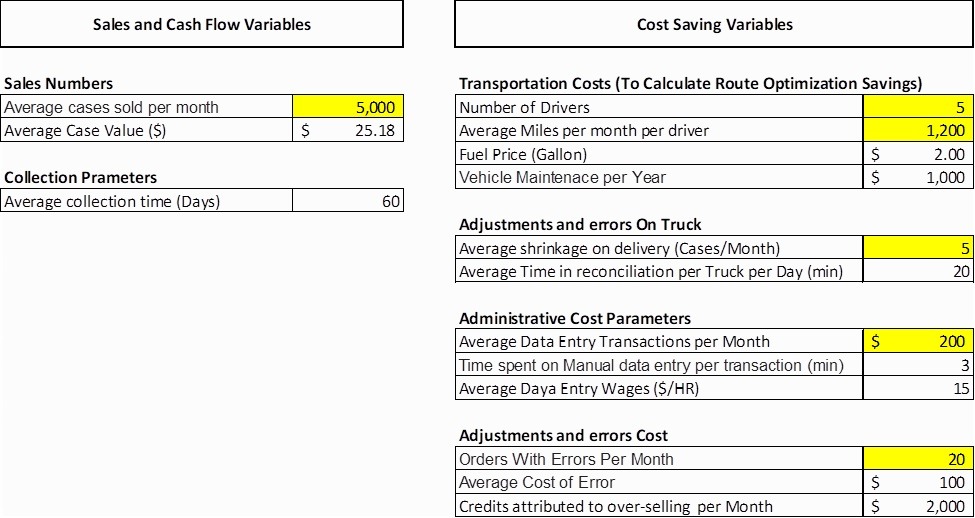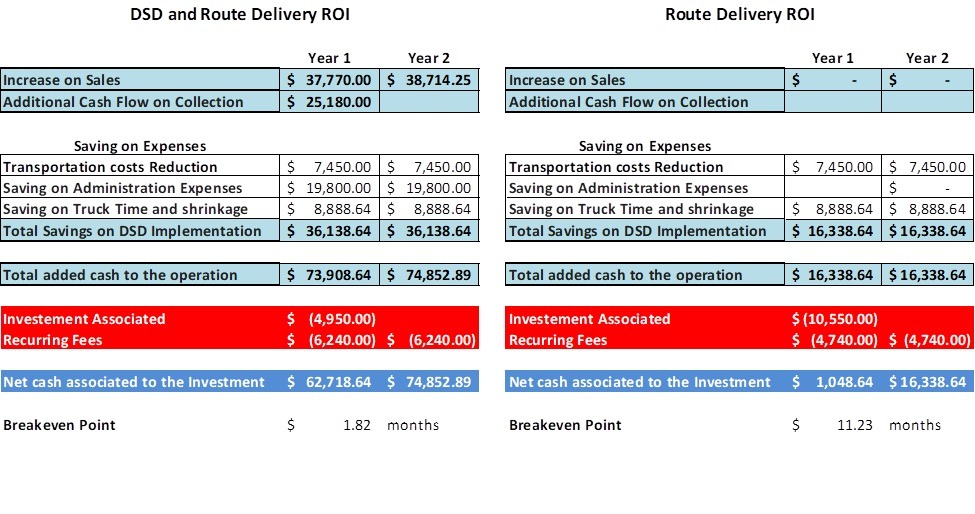
A Spreadsheet to Calculate a Route Delivery System and DSD ROI
Many distributors star their operations with manual controls for the sales and delivery at the stores. However, as the company starts growing, they will face challenges such as inefficient inventory management, prolonged delivery times, and limited visibility into sales data, all of which affect the net profit. Switching to a DSD system is the way to counteract these challenges. But how do you quantify the return on investment (ROI) of such systems? As we developed an Excel model to calculate the ROI of a WMS, we developed an Excel spreadsheet that can help in calculating the route delivery system and DSD ROI. In this article we analyze how to use it.
What are the savings of a DSD and Route Delivery system?
Transportation Cost Savings: One of the primary areas where businesses see significant savings is transportation costs. By optimizing delivery routes and schedules through DSD software, companies can reduce fuel consumption, vehicle maintenance costs, shrinkage, and driver overtime. Additionally, eliminating manual data entry and paperwork associated with traditional delivery methods further streamlines operations, saving time and resources. Moreover, by decreasing adjustments and truck reconciliation time minimizes inefficiencies, leading to tangible cost savings.
Administrative Cost savings: By transitioning to automated data entry mechanisms within Direct Store Delivery (DSD) systems, distributors can streamline their operations, minimizing the time and resources traditionally allocated to manual record-keeping. Moreover, by implementating precise inventory tracking and order management functionalities helps mitigate the risk of overselling, thereby reducing the need for costly error corrections and credit processing.
Increased Sales Opportunities: DSD and route delivery systems empower businesses to capitalize on increased sales opportunities through various mechanisms. Firstly, promotions controlled by the DSD software allow for targeted marketing efforts, driving consumer engagement and boosting sales. Furthermore, leveraging sales history data enables businesses to identify trends and preferences, leading to more informed product offerings and increased sales volumes. Additionally, the ability to control visit schedules ensures that no opportunity for sales is missed, further enhancing revenue generation.
Enhanced Cash Flow: A crucial aspect of ROI calculation lies in evaluating the impact on cash flow. DSD and route delivery systems facilitate increased collections through features such as outstanding invoice management directly on driver devices. By streamlining the invoicing and payment process, businesses can accelerate cash inflows, improving liquidity and reducing reliance on external financing. Moreover, enforcing strict collection policies, such as not delivering goods without collecting payment, safeguards against revenue leakage and strengthens financial stability.
Consideration of Implementation Costs
While the benefits of DSD and route delivery systems are evident, it is necessary to consider the upfront implementation costs. These typically include investments in hardware, setup fees for software integration, and ongoing monthly license expenses. While these costs represent an initial investment, you must assess them in the context of the long-term benefits and cost savings offered by the system. A comprehensive ROI analysis should weigh these implementation costs against the anticipated savings and revenue gains to determine the overall profitability of the investment.
Variables in the DSD ROI Model
The table shows the variables to consider when estimating the DSD ROI. The cells highlighted are the variables related with the size and efficiency of the operation. The values shown are representative and used solely with the purpose of illustrating the ROI.

Calculating the DSD ROI
Once the data is input in the spreadsheet, it automatically calculates the WMS ROI based on the degree of automation desired: A full DSD with Route Delivery, and only a Route Delivery System. The spreadsheet also considers the ROI of just the Pre-Sale module of a DSD System. For these values, which are pretty standard, the company will be increasing its profits in the order of $135,500 by year 2, and the investment is recovered in 2 months.

I hope this article about DSD ROI has been helpful to you. I will continue to post information related to warehouse management, distribution practices and trends, and the economy in general. If you are interested in learning more, click the link, and we will call you.
There is a lot of relevant information on our channel. Check this video on How to calculate the ROI of a WMS.


Sorry, the comment form is closed at this time.